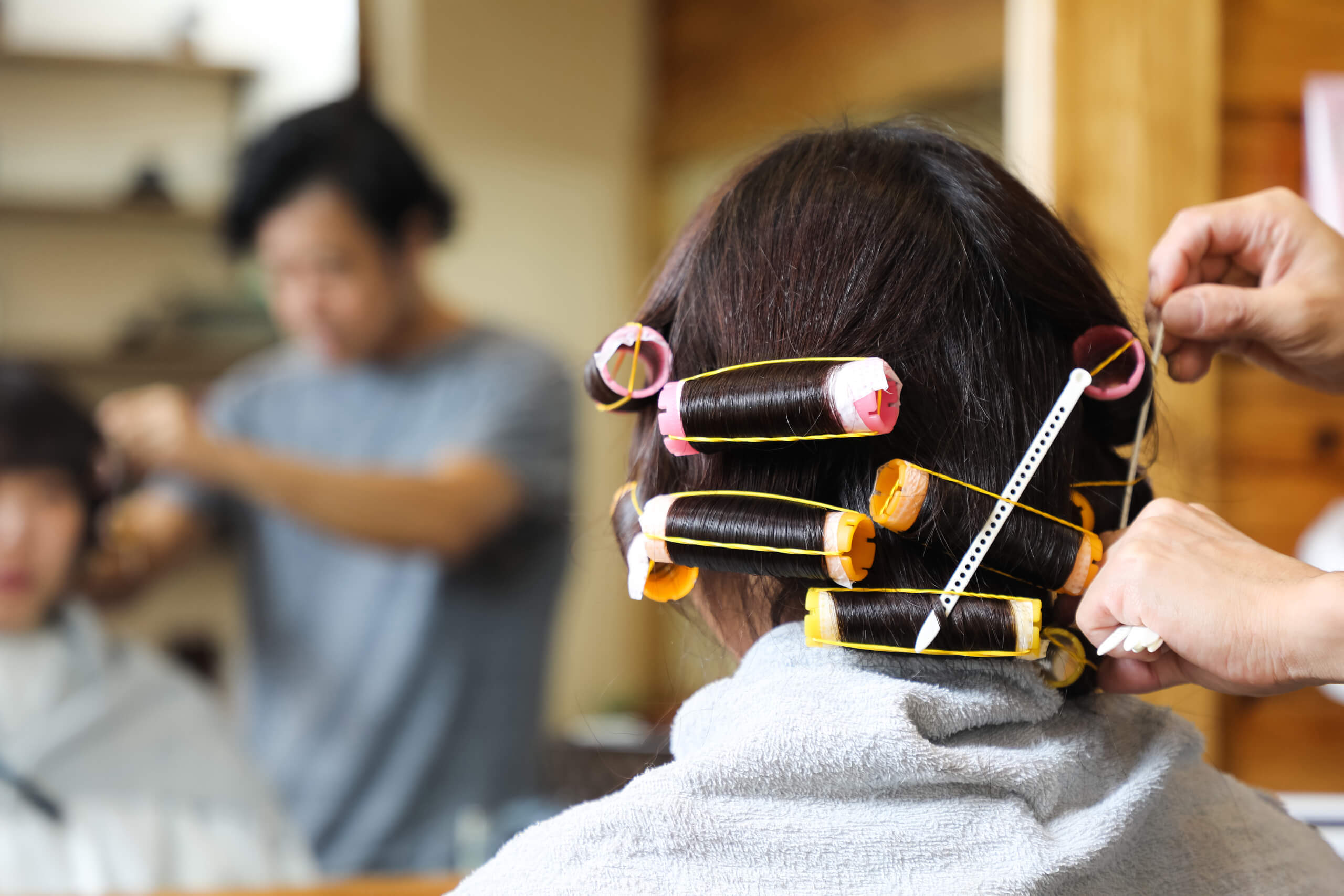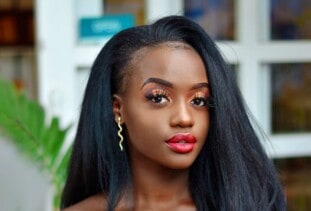If you want more voluminous hair, waves, or curls, a perm might be a good choice. With 11 common types of perms, you’re sure to find one that not only works with your hair type and length but also gives you the look you’ve been searching for.
Some perms work best for short hair while others are better for long hair. You also have to factor in whether you have thick or thin hair as well as your curl pattern.
We discuss the types of perms you can get based on your hair type, the perming process, and other considerations before booking your next appointment.
What Is a Perm?
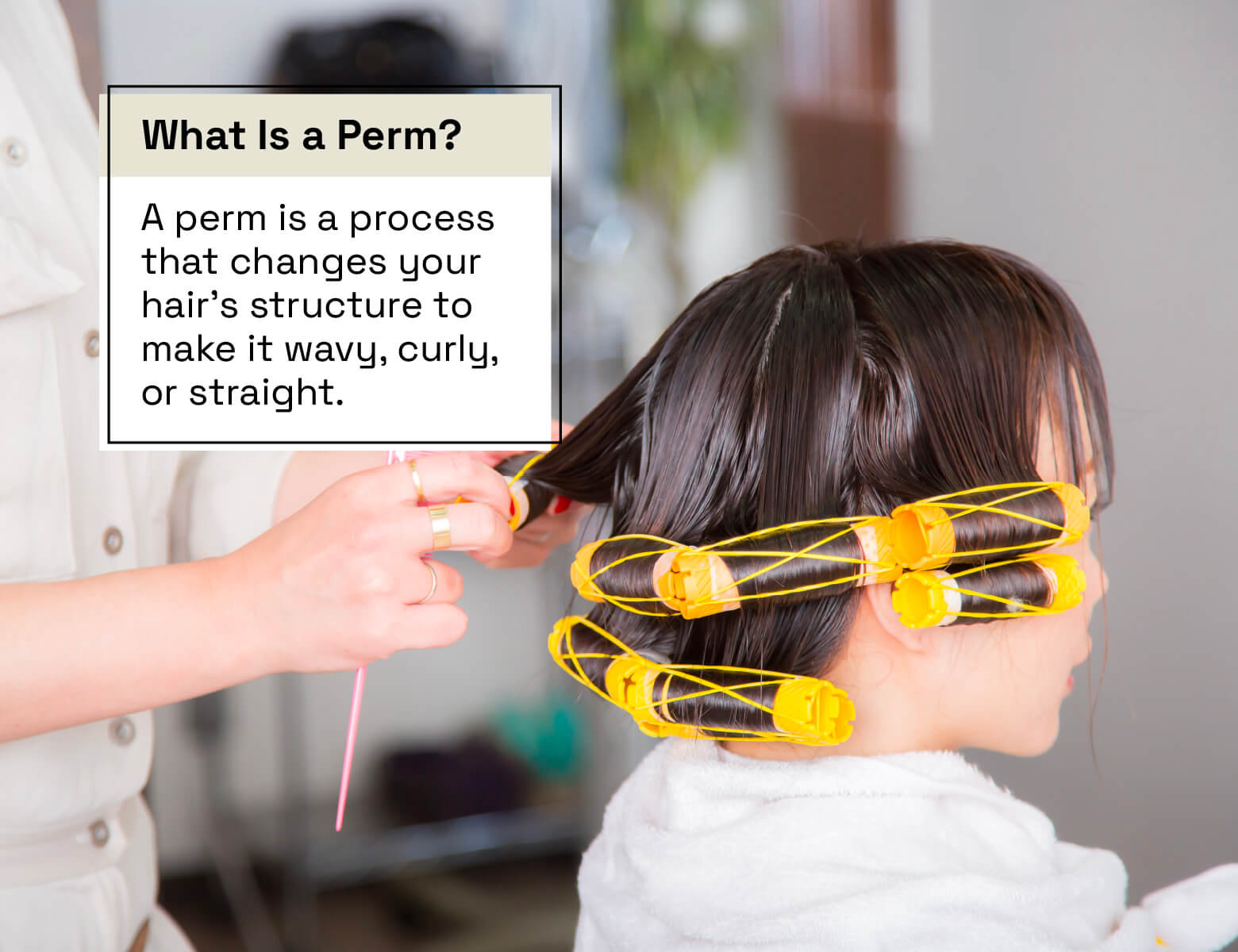
A perm is a styling process that changes the structure and texture of your hair permanently, whether it’s by making your hair wavy or curly, or by adding volume and straightening your hair. This is typically achieved using foam rollers, which remind you of traditional curlers, or perm rods, which are small rods that sections of your hair are wrapped around.
It’s important to note that while nearly all hair types can get perms, people with damaged hair should avoid getting a perm, as perming can make that damage worse.
Hot vs. Cold Perming Methods
There are two main perming methods, either hot or cold, with the different methods impacting your final look. Perm rod sizes will also impact your final look, as larger rods create natural-looking waves and smaller rods produce tighter curls.
The differences between the methods and how they affect your hair are outlined below:
- Hot perms: The acidic chemical glyceryl monothioglycolate breaks down the disulfide bonds in your hair, while heat is added to create the shape of your curls. Although this method takes longer to set, it’s gentle compared to alternatives and is best for finer hair. Another, more expensive, type of hot perm, called digital perms, uses rods that are temperature controlled by a machine to avoid heat damage to your hair.
- Cold perms: Also called alkaline perms, this type of perm uses a chemical solution of ammonium thioglycolate to produce curls without heat. While curls can be tighter and more defined and last longer with this alkaline solution method, it isn’t recommended for weak or thin hair.
Types of Perms Based on Hair Type
Certain types of perms will be best for specific hair types and lengths, so we compiled a chart based on the hair type and length, perm styles, and look achieved so you can find the perm that’s best for you.
| Type of Perm | Hair Type | Hair Length | Look Achieved |
| Root perm | Straight or thin | Short to medium | Volume at the root |
| Digital perm | Straight or thin | Short to long | Waves or curls |
| Volumizing perm | Straight or thin | Short to long | Volume with loose curls and waves |
| Body wave perm | Straight or thin | Medium to long | Loose waves |
| Beach wave perm | Straight or wavy | Medium to long | Loose waves |
| Multi-textured perm | Straight or wavy | Medium to long | Natural, fewer uniform waves |
| Pin curl perm | Straight or wavy | Medium to long | Soft waves |
| Stack perm | Straight or wavy | Short to long | Volume at the root with curls and waves on the bottom half of your hair |
| Straight perm | Curly or wavy | Short to long | Straightened |
| Partial perm | Curly or thin | Short to long | Specific parts are curled |
| Spiral perm | Curly or thin | Medium to long | Tight ringlet curls |
Perms for Straight or Thin Hair
Most people with perms have straight or thin hair, as a perm can remedy flat hair that lacks volume or doesn’t have a wave or curl to it. Below are the various perms for people with this type of hair.
1. Root Perm
If you have straight or flat hair and want more volume, a root perm might be right for you. Keep in mind that if you have thin or fine hair, your results may not be as noticeable.
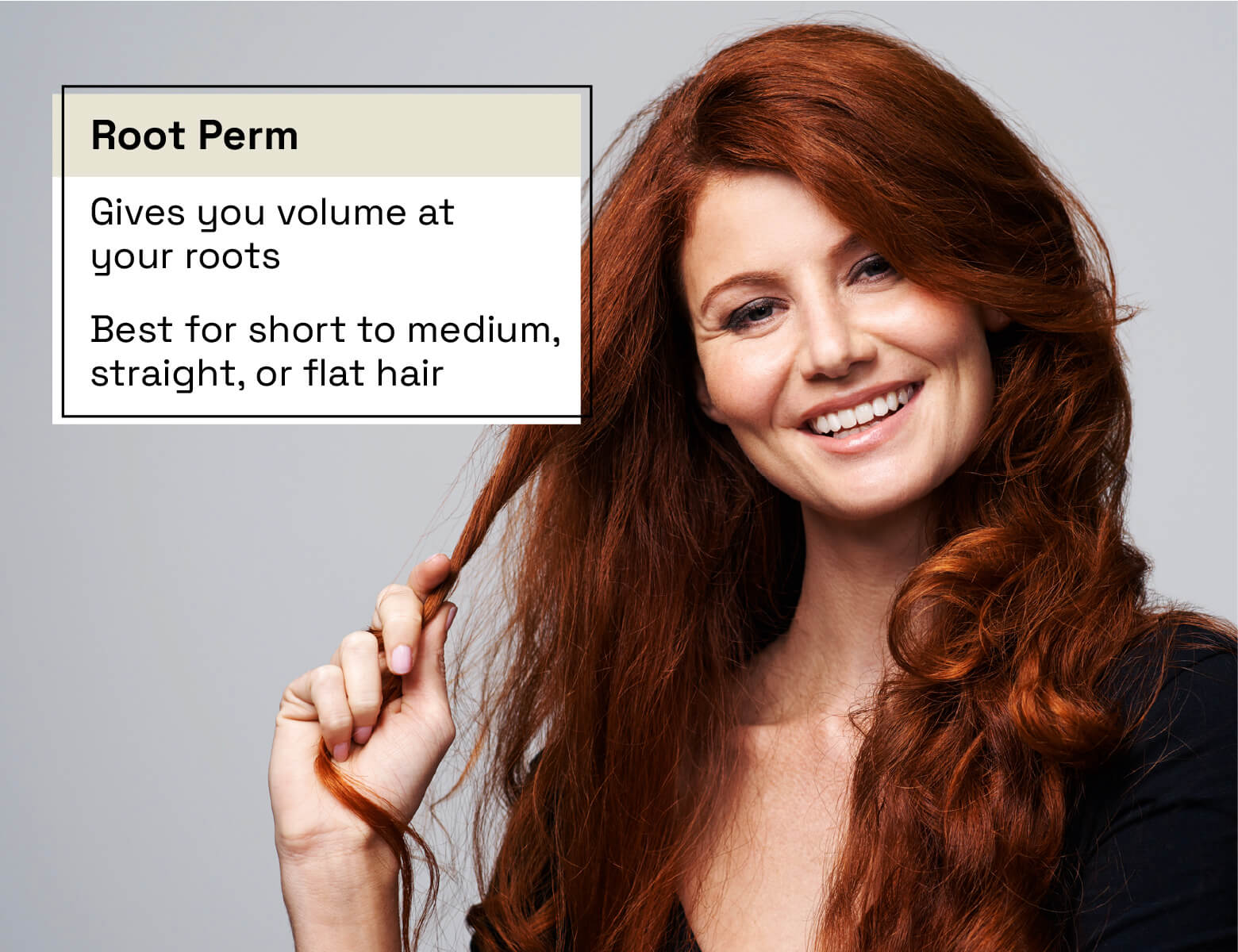
The process: To achieve the root perm, your hair will be wrapped at the roots with small rollers, a prepping perm solution is applied, and then your hair receives a shaping solution along with a final wash and style.
Works best for: Short to medium-length hair, so talk to your hairstylist if you have long, heavy hair that could potentially weigh down the volume.
Timeline: Root perms give you volume at your roots for about six months, decreasing the chances of hair damage since the root perm only concerns your roots, not the rest of your hair.
2. Digital Perm
The digital perm offers a more modern perm type that was invented in Japan. It creates waves or soft curls.
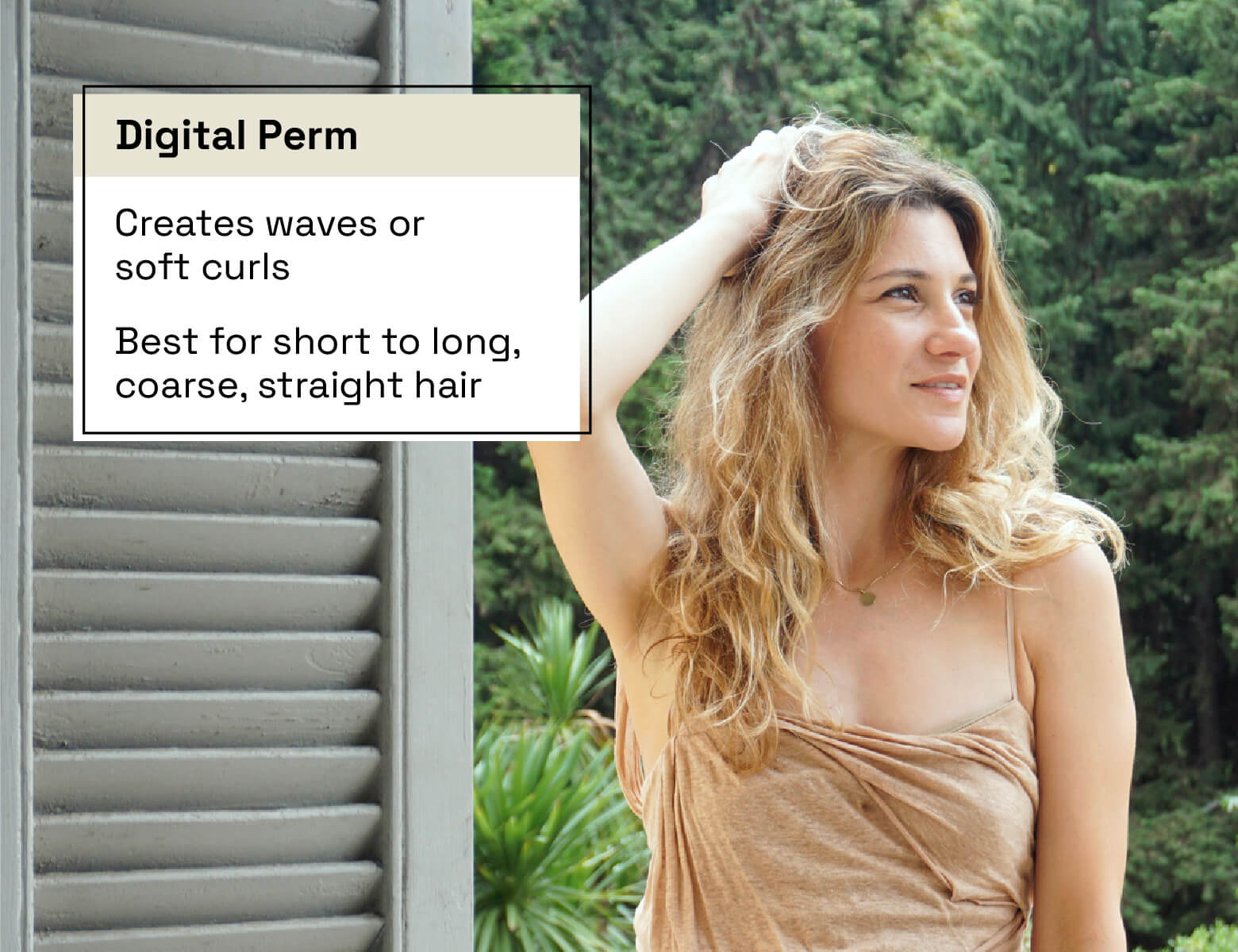
The process: This hot perm uses an acid solution to break your hair’s bonds and allow it to be reshaped. Your hair will then be wrapped around perm rods that are temperature regulated by a machine for 30 to 90 minutes. After the rods are removed, a neutralizing solution is added and the shape is set.
Works best for: All types of hair, although it’s best for coarse, straight hair. Additionally, you’ll want to avoid getting a perm if your hair is damaged or recently bleached.
Timeline: With proper maintenance, your digital perm could last up to a year, although you may need to touch it up every so often as your roots will grow straight.
3. Volumizing Perm
A volumizing perm uses waves and curls, rather than tight curls, to give straight or thin hair more volume.
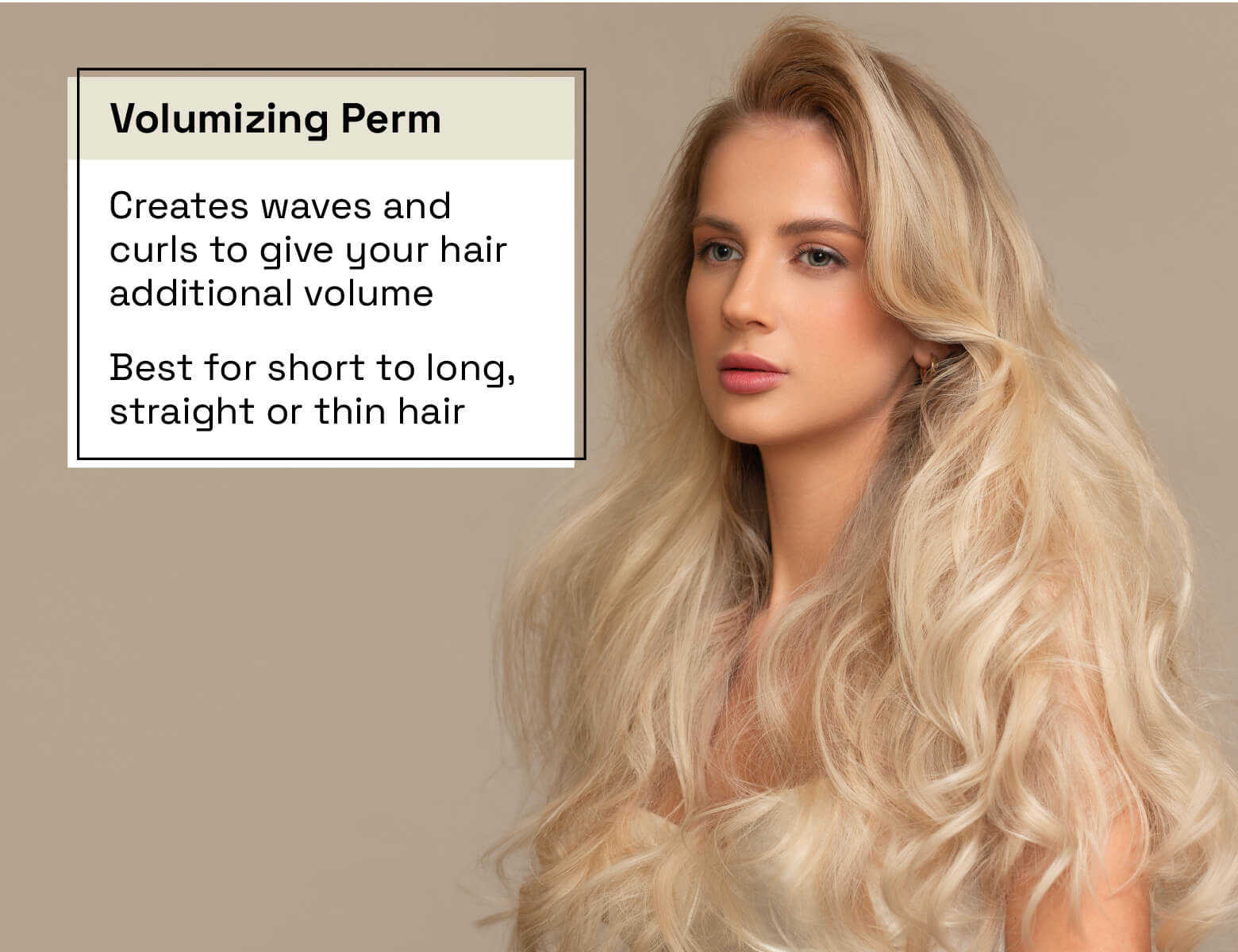
The process: The process is similar to that of other perms, but the rods are removed before the neutralizing solution, making your curls looser and giving your hair more volume. This will give you volume at your roots and curls or waves near the bottom of your hair.
Works best for: Straight or thin hair that is lacking volume
Timeline: Since this perm only provides volume, it will typically only last about six weeks.
4. Body Wave Perm
Body wave perms are best for straight or thin hair whose length is medium to long, acting as a great alternative to the root perm.
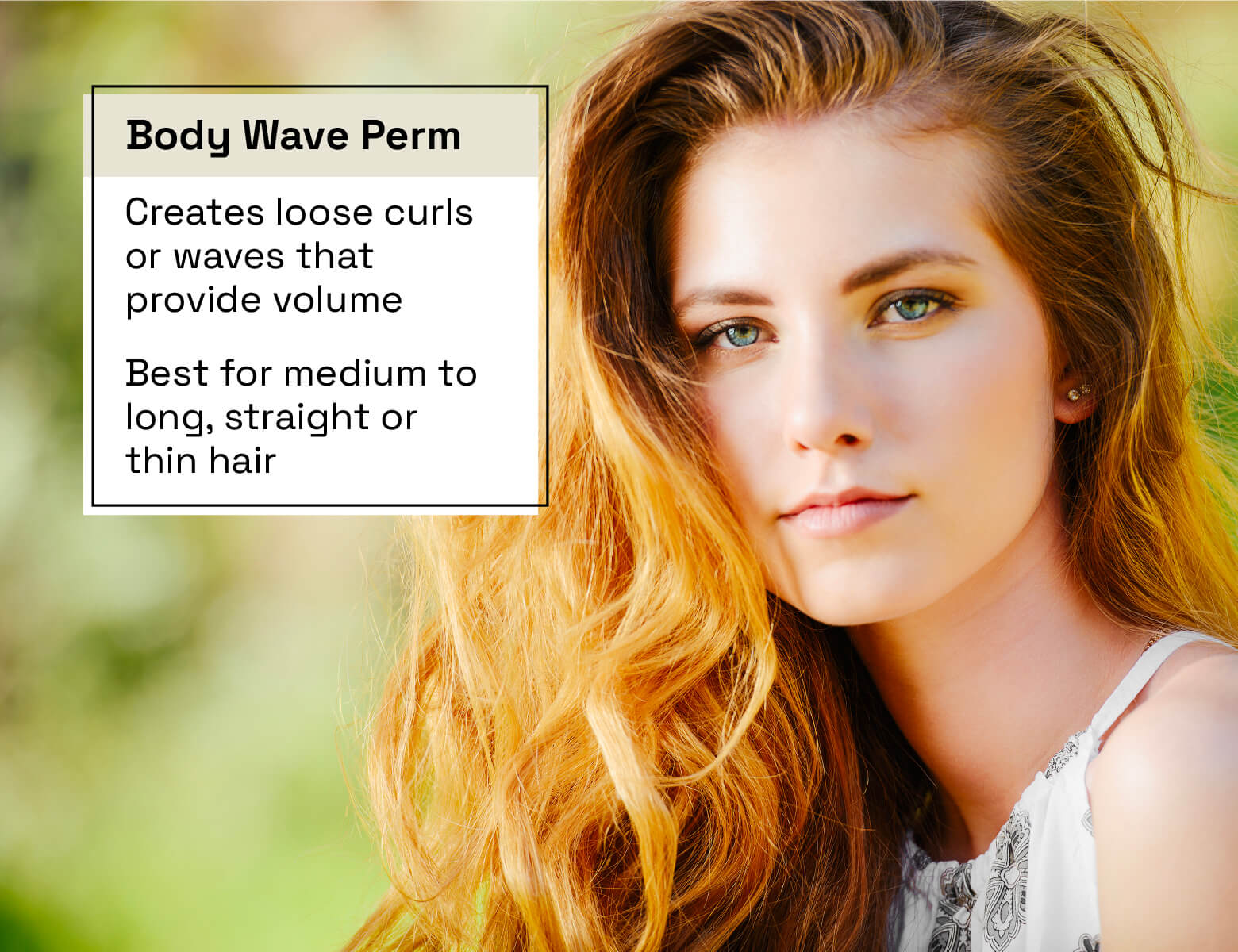
The process: The process involves wrapping your hair in large rollers with the perm solution applied. Then, by using medium or large perm rods, your hair will produce a looser curl that also increases volume.
Works best for: Medium to long, straight or thin hair
Timeline: Since these waves are looser, this perm will usually only last about six to twelve weeks.
Perms for Straight or Wavy Hair
If you have curly hair but lack volume, or if you have wavy hair, you might consider the following perm types.
5. Beach Wave Perm
Just as it sounds, a beach wave perm makes your hair look like you just stepped off the beach, giving it beach waves instead of tight curls.
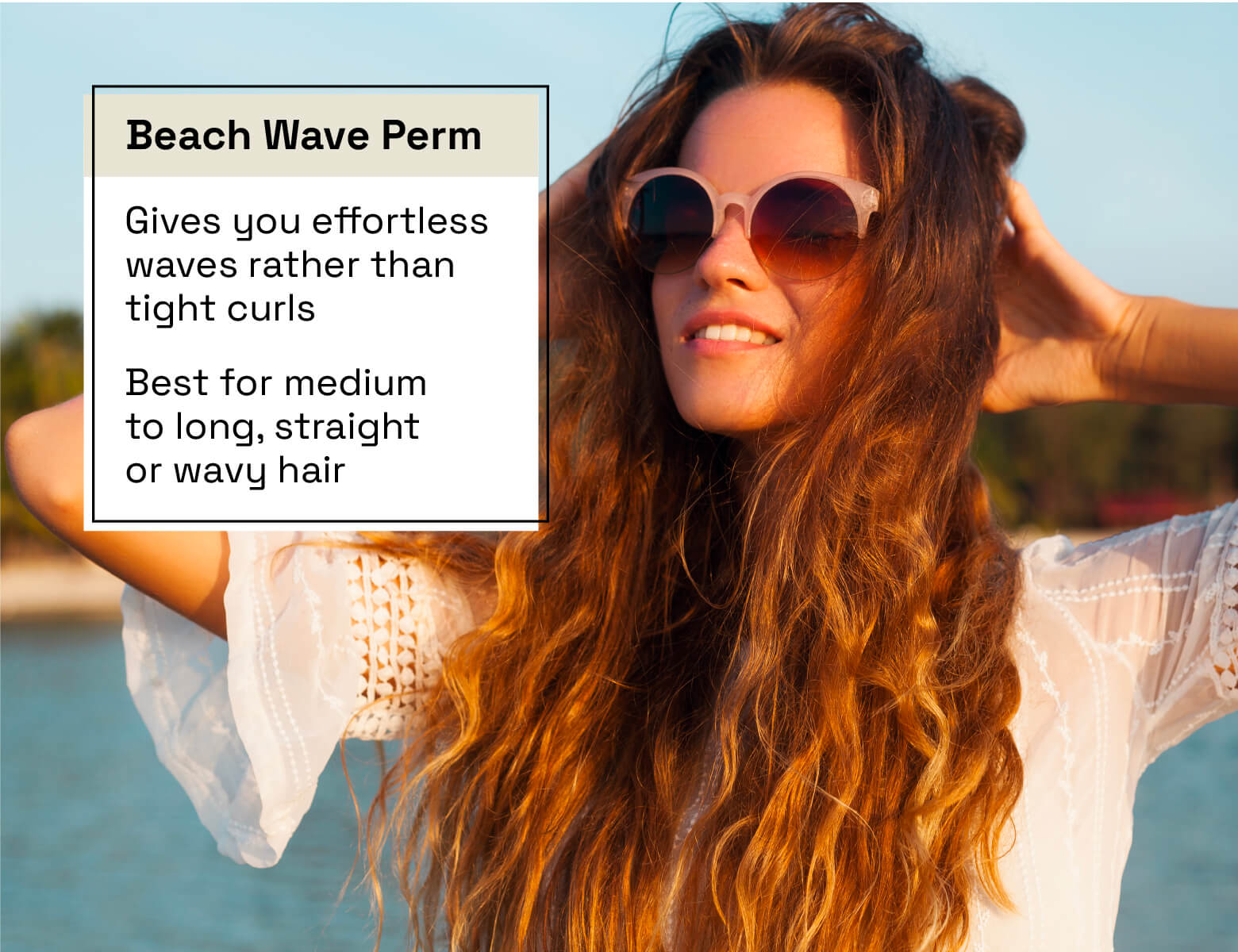
The process: Achieving this look is similar to that of traditional perms, except your stylist wraps your hair around foam rollers instead of perm rods.
Works best for: Straight or wavy hair that’s medium to long in length.
Timeline: Beach waves are loose waves with some volume, so you can expect this perm to last about six months.
6. Multi-Textured Perm
Multi-texture perms give you waves that look more natural and have more variation to them.
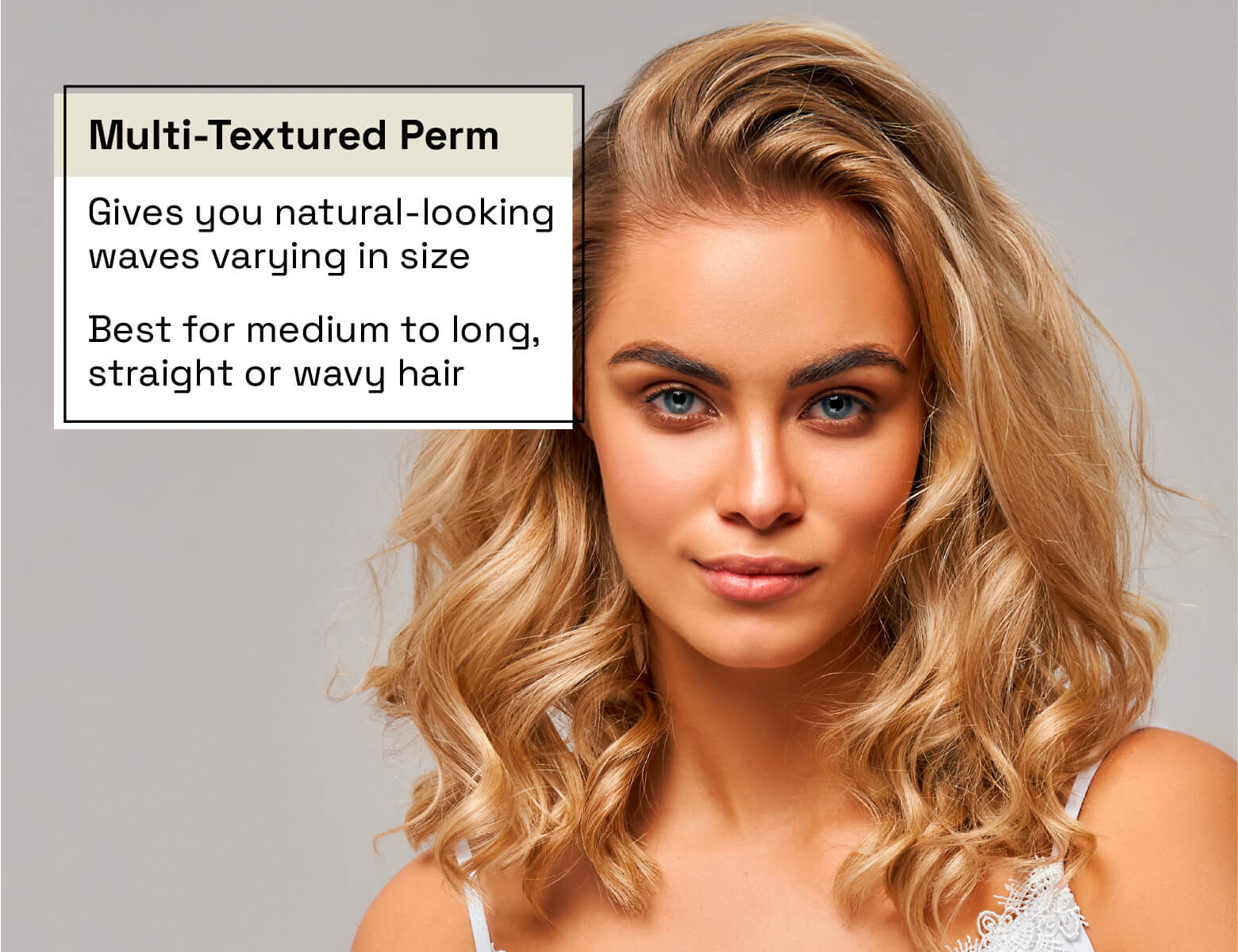
The process: Following the typical perm process, different rod sizes give you various sizes of curls or waves.
Works best for: Medium or long hair with a straight or wavy texture
Timeline: This perm should last about three to six months.
7. Pin Curl Perm
The pin curl perm used to wrap hair around pins instead of perm rods to give you soft waves, and some stylists may still do it this way.
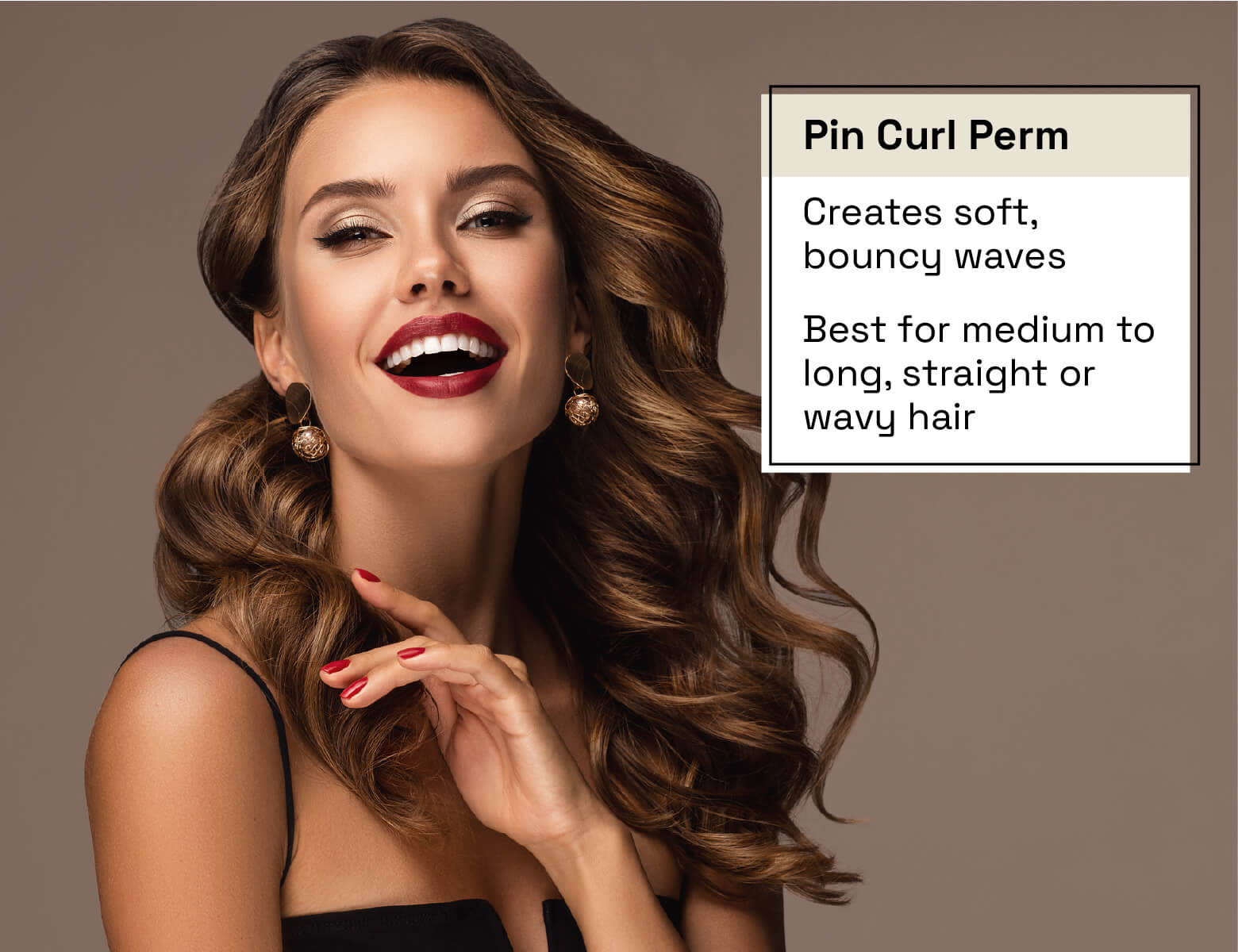
The process: Your stylist will section your hair into curls, roll the curls with rods, and then pin the curl to your head using a bobby pin. A solution is applied and processed, and then a neutralizer is applied before the pins are removed, the hair is rinsed, and, finally, styled.
Works best for: Medium to long, straight or wavy hair
Timeline: Like the multi-textured perm, this should last about three to six months.
8. Stack Perm
This perm is perfect for people who don’t have layers but want to achieve that volumized, layered curl look.
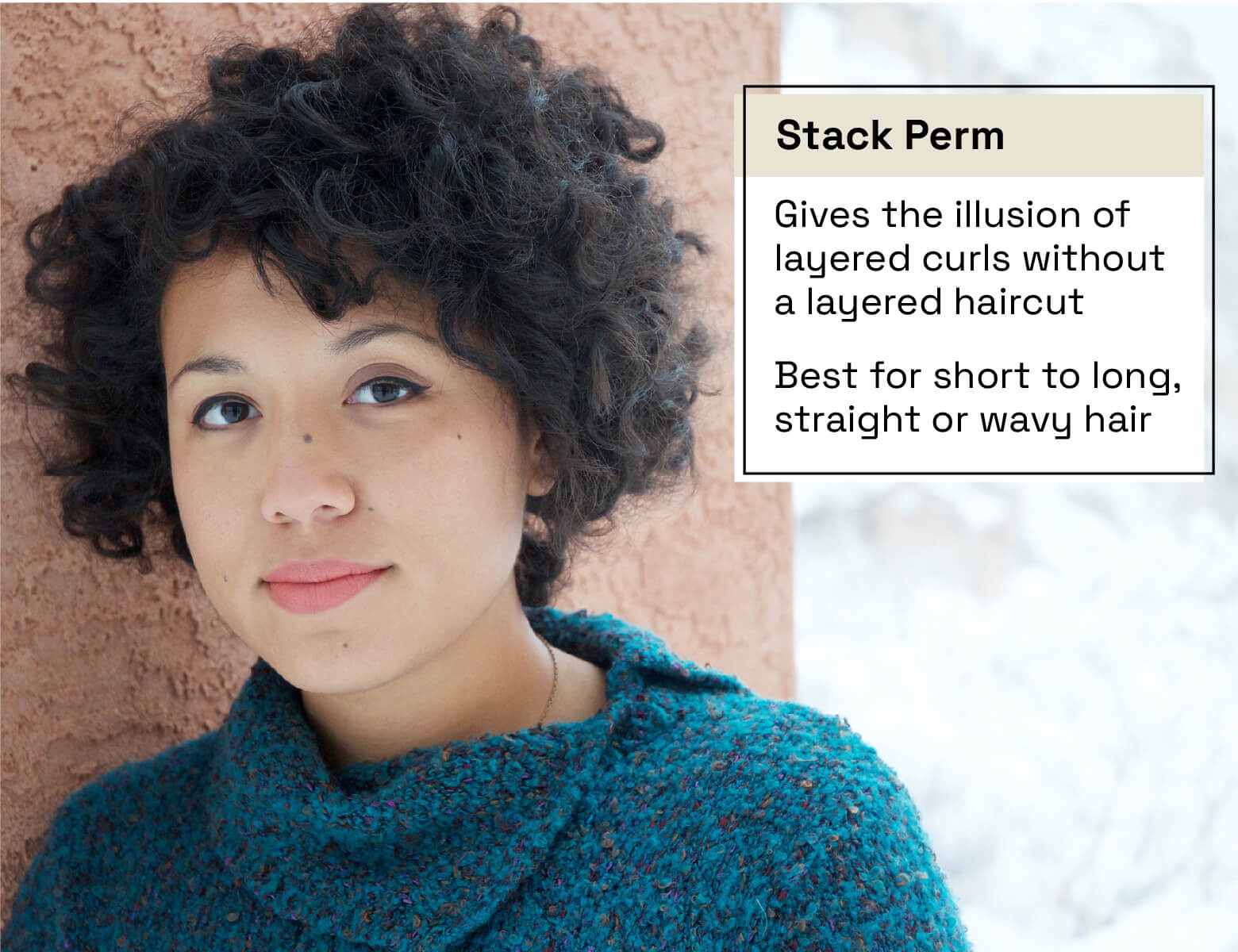
The process: Your stylist will apply the perm solution to your hair and wrap your hair around different-sized rollers. Once your hair is set, the stylist applies the neutralizer before removing the rods, leaving you with layered curls.
Works best for: A stack perm is for people who have straight or wavy hair and medium to long length.
Timeline: This perm lasts about six months.
Perms for Curly or Thin Hair
For those of you with natural curls or wavy hair, never fear! There are perm options for you.
9. Straight Perm
Also called the reverse perm, this perm does not curl your hair — it straightens it.
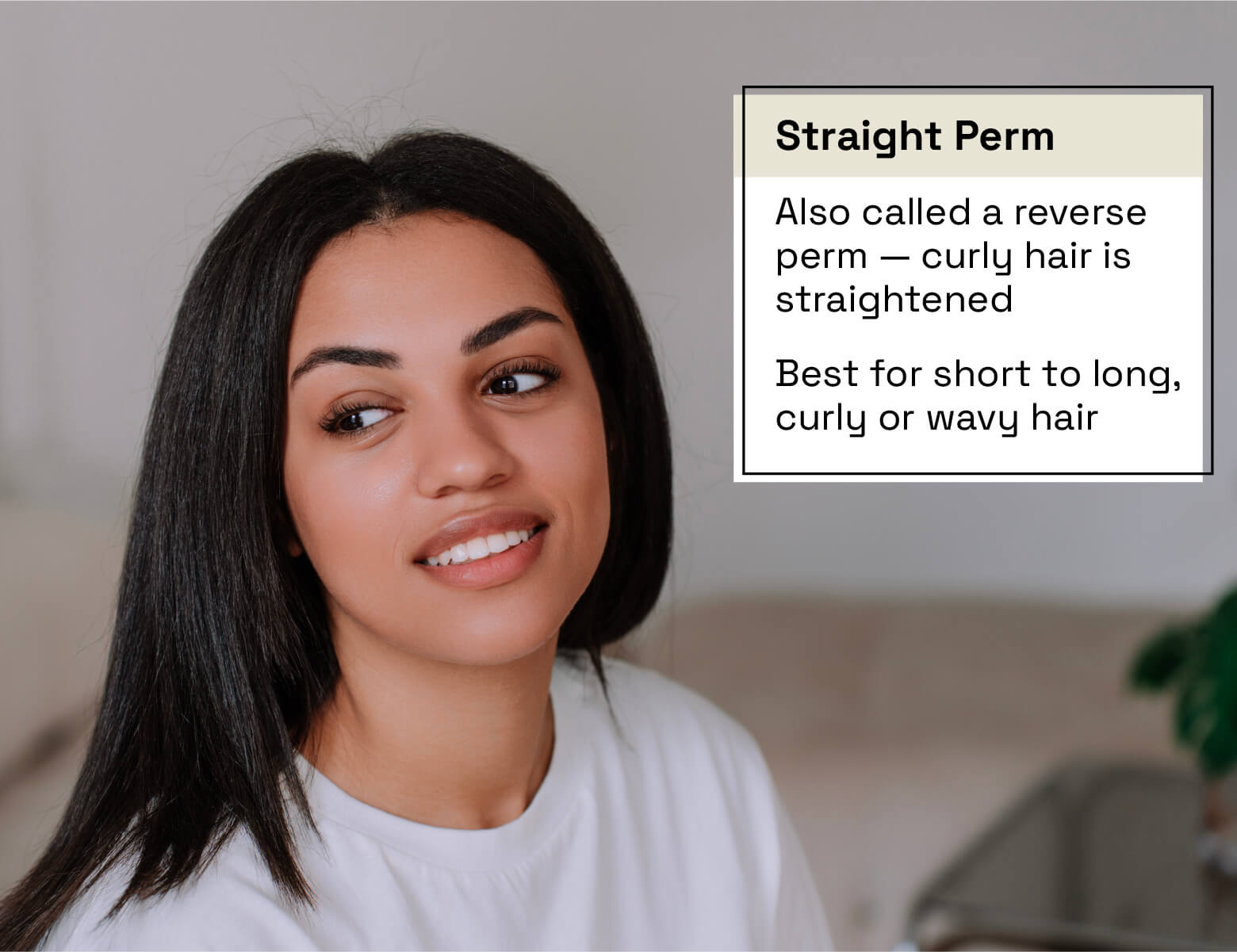
The process: Your hair will be covered in a straightening solution, then left under a heater before washing and straightening it.
Works best for: Short to long, curly or wavy hair
Timeline: This perm will last around three months, but keep in mind, this perm is damaging to your hair.
10. Partial Perm
A partial perm can also be called a spot perm, as a part or section of your hair is curled, instead of all of it.
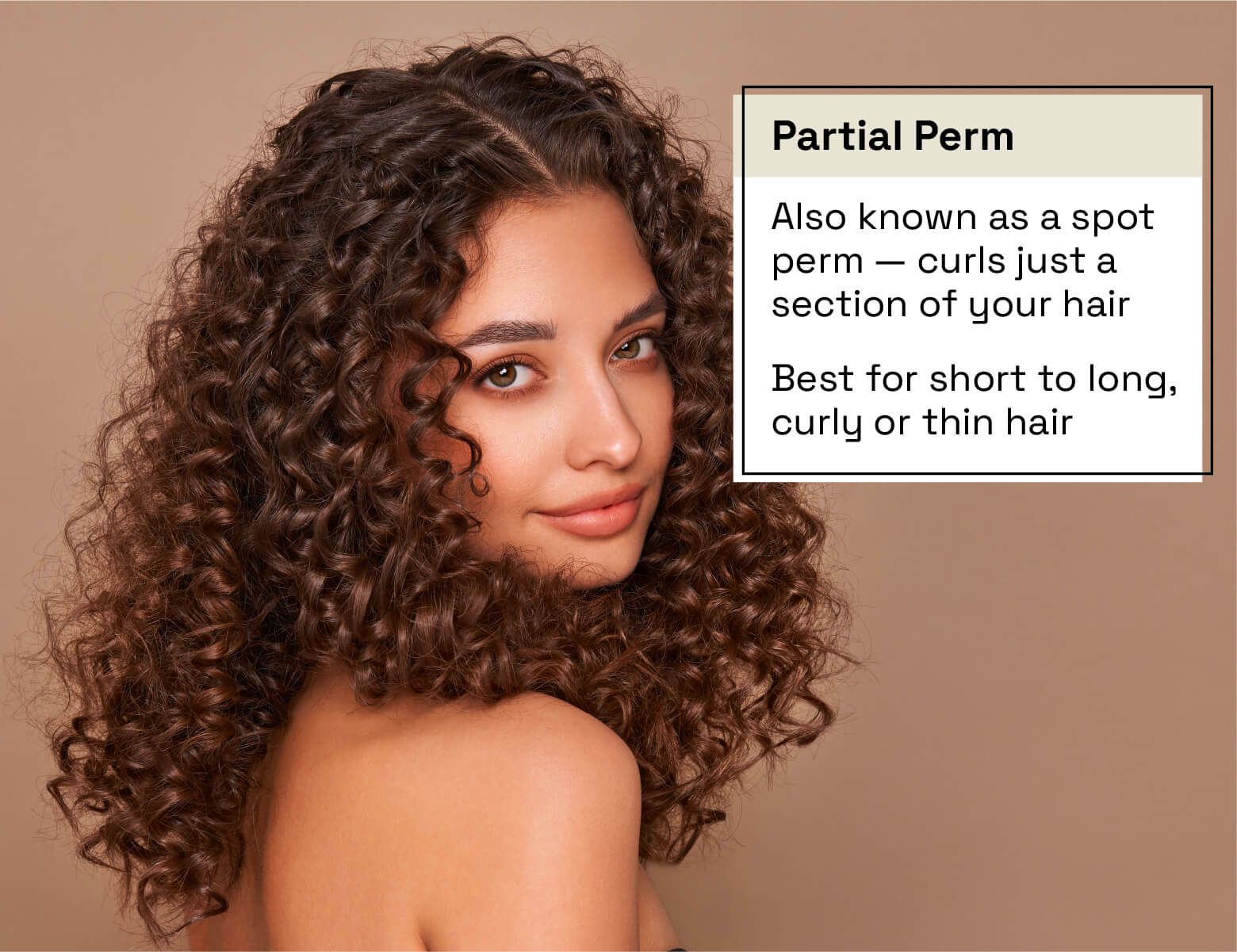
The process: The process for this perm is the same as any other perm, except the stylist will wrap your hair around rods in only one section of your hair.
Works best for: Short to long, thin or curly hair that needs additional volume or curls at the ends or near your roots
Timeline: The partial perm can last for three to four months.
11. Spiral Perm
A spiral perm is one of the most common perm types, giving you tight, bouncy curls.
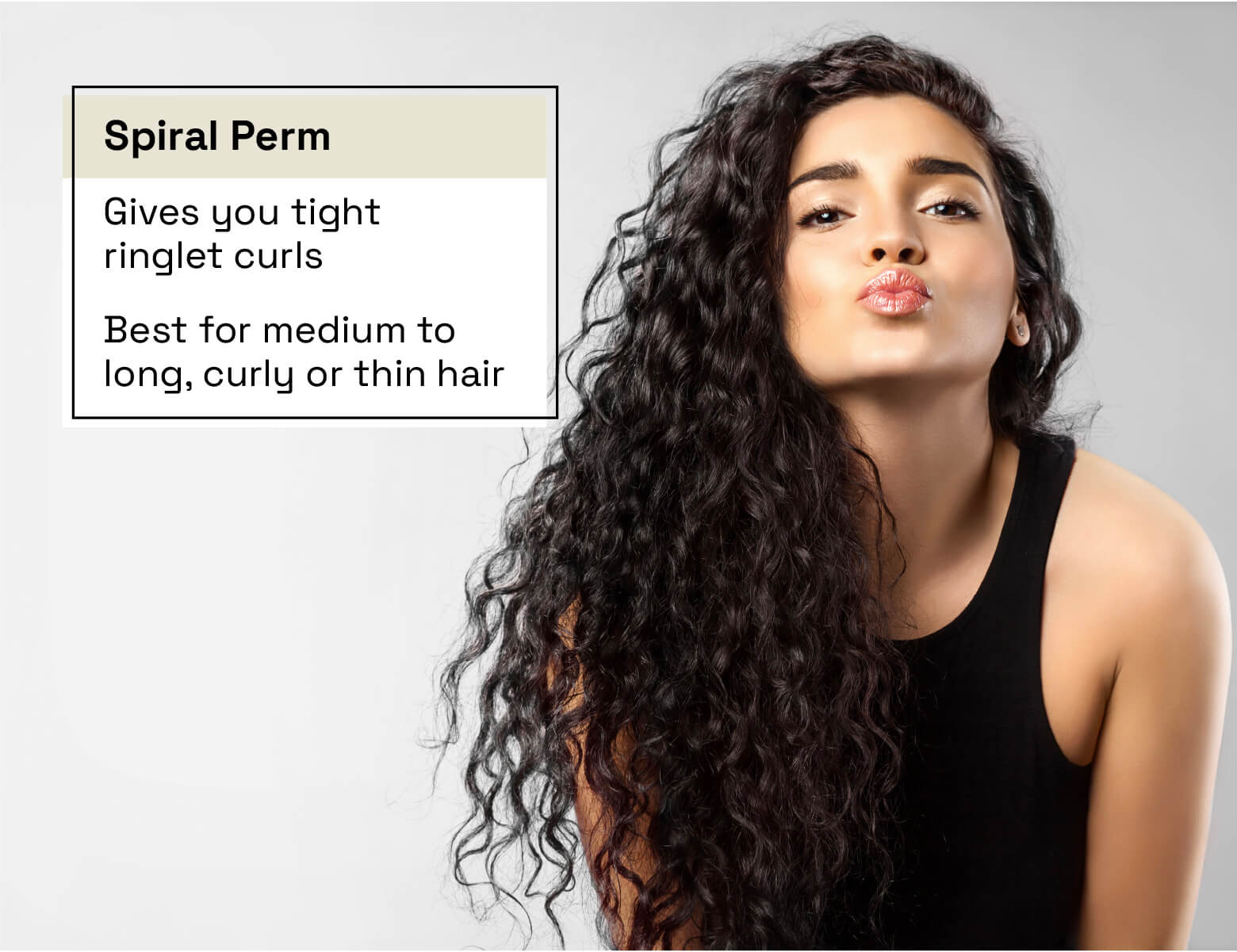
The process: Your hair is wrapped vertically around the perm rods during the perm process, and you can choose the size of spiral curls you want by increasing or decreasing the perm rod size.
Works best for: Similar to the partial perm, a spiral perm works best if you have curly or thin hair.
Timeline: Once achieved, your spiral perm look will last about six months.
What Is the Perming Process?
So, now that we’ve discussed the different types of perms, it’s time to understand the perming process itself. The perming process can take anywhere between 1–5 hours.
- Wash your hair with clarifying shampoo. This removes oil to prepare your hair for the perm solution.
- To start the perming process, your stylist wraps your hair around rods. The stylist heats the rods if you’re getting a hot perm.
- Your stylist applies a solution to your hair for a hot perm and a lotion for a cold perm. With a hot perm, the solution changes the hair texture.
- Your hair sets for a certain amount of time. Depending on the type of perm you’re getting, your hair will need to process the solution to keep the desired style.
- Your stylist rinses out the solution and washes your hair.
- Your stylist dries your hair and styles it.
- Finally, if you’re getting a cold perm, your stylist applies a neutralizer to stop the chemical process.
Considerations Before Getting a Perm
Just as you do anytime you change your hairstyle, it’s important to consider several factors. Just as the name implies, a perm is permanent (at least for a while), so be sure you understand what exactly you’re getting into.
You must do some low maintenance.
Perms can last about two to six months — tighter curls will likely last longer. Be sure you understand the maintenance that comes along with the perm you choose, and be ready to rock the style for several months.
Your hair length will be shorter.
Adding curls changes the length of your hair, so you should consider that before getting a perm. You may not be able to wear your hair up in a ponytail anymore if that means having to stretch the curls to reach the band. The tight band and other updos that stretch your permed hair can create uneven curls.
Check that your hair type, length, and texture are ideal for the perm type you want.
Having healthy hair is the best way to ensure a successful perm. Soft, fine hair is even better as this type of hair can be restructured the best, while those with naturally curly hair may not be good candidates for perms. If your hair is already damaged, remember that a perm has the potential to damage it more.
You should avoid color treatments.
To avoid additional damage, limit your hair color treatments like dyeing or bleaching. The additional harsh chemicals applied for color can affect the chemical process that your hair undergoes during a perm, potentially damaging your hair further.
Perms can be costly.
Average costs for perming your hair can range from $30 to $400, depending on a lot of factors. The type of perm, where you live, your current hair texture and type, as well as hair health, can all affect the price of your perm.
You could cause additional damage to your hair.
While it’s less damaging than bleaching or permanent coloring, the chemicals used to change the structure of your hair to be more curly or wavy may damage it. By subjecting your hair to chemicals and heat, you can run the risk of hair breakage and damage.
How Much Does a Perm Cost?
The average cost of perming your hair can be anywhere from $30 to $400. This wide range depends on several different factors:
- The type of perm
- Where you live
- Your current hair texture and type
How Long Does a Perm Last?
Perms typically last three to six months. While the style itself may fade away, it’s a permanent hairstyle in that it will completely change the texture of your hair. This means you will have to grow your hair out completely before your hair goes back to normal. If you like your perm, you can go back and get touch-ups done to keep the style intact.
Can Perms Damage Your Hair?
While perms have the potential to damage your hair, they’re a lot less damaging than bleaching or coloring your hair. The chemicals used in the perm solution change the structure of your hair, but you can mitigate damage by using salon-quality products that reduce damage and bring in moisture to your hair.
Aftercare Tips for Perms
So, you did it! You got your perm. What happens next?
Here are some aftercare tips for newly permed hair.
- Wait to wash your hair within 48 hours. You don’t want to ruin the chemical process that just occurred in your hair, so go without washing it for a few days.
- Get hair care products for permed hair. Salon-quality products can help increase moisture in your hair while reducing damage.
- Try hair masks to strengthen and moisturize your hair.
- Avoid damaging your hair further with other treatments or products. Don’t try to bleach or color your hair.
- Get your hair cut regularly. Keep your new look fresh longer by getting regular trims.
If a perm sounds like it’s right for you, then it’s time to find a stylist. Once you’ve made your decision to get a perm, you can find an experienced stylist through StyleSeat. After meeting with your Pro, you can discuss which perm would be best for you and your hair.
